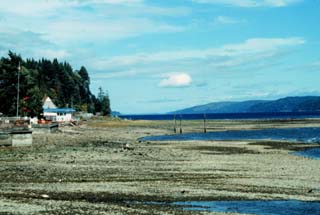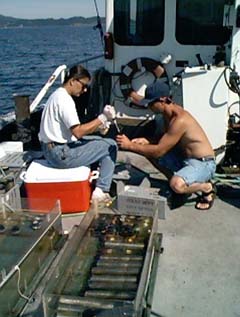
Surveys
DJC.COM
July 29, 2004
Troubling times for Hood Canal's waters
Puget Sound Action Team

Fagergren
|
Dead fish are a sign of a waterway in trouble. Immediately scientists and volunteers set out to find the causes of the fish kill.
All signs pointed to a lack of dissolved oxygen in the water — oxygen that is critical for the survival of fish.
Intensified water testing revealed that dissolved oxygen in Hood Canal is at its lowest level in recorded history, compared to data collected in the past 50 years. The canal has a history of low dissolved oxygen levels, with fish kills documented back to the early 1960s and earlier.

Hood Canal communities have seen tremendous growth in recent years.
Photo courtesy Puget Sound Action Team
|
This time the problem is more acute. In recent years, the extent of low oxygen in deep waters is greater, and these levels stay low year-round instead of rebounding in the winter.
"We cannot let Hood Canal become the 'dead sea' of Puget Sound," said Brad Ack, director of the Puget Sound Action Team. "We can and must take actions now to address the causes of this serious problem."
The problem in Hood Canal
Hood Canal isn't alone in this problem. "Dead zones" are real phenomena that have hampered the Gulf of Mexico and Chesapeake Bay for years.
According to the United Nations Environment Programme's Global Environment Outlook Year Book published earlier this year, more than 150 oxygen-starved zones exist around the world. The report states that these areas have steadily increased since the 1960s, and the number of known locations around the world has doubled since 1990.
Many factors contribute to the low dissolved oxygen problem in Hood Canal. Some of these are naturally occurring, including: poor circulation and flushing of the canal; the canal's great length coupled with great depth in the middle, with a shallow north end and shallow, blocked south end; and the degree of stratification of the seawater at depth and freshwater at the surface that restricts vertical mixing.
People also contribute to the problem by adding nitrogen to the canal from fertilizers, human sewage, animal manure and decaying fish carcasses.
When released into the water, the nitrogen helps microscopic algae and other aquatic plants grow. At first, plant growth adds oxygen to surface waters, but when the algae die and decompose, they rob oxygen from the water that fish, shrimp and other aquatic life need to survive.
Changes to the rivers flowing into Hood Canal through damming or other engineering practices can affect the delicate balance of fresh and saltwater circulation. These changes may also contribute to the low-dissolved oxygen problem.
In May, the Action Team and Hood Canal Coordinating Council issued the Hood Canal Low Dissolved Oxygen Preliminary Assessment and Corrective Action, which identified the primary human causes of nutrient pollution, and the most feasible corrective actions or fixes to those problems.
The study determined that the primary sources of nitrogen associated with human activities collectively put between 100 to 300 tons of nitrogen into the canal every year, broken down as follows:
- 60% human sewage
- 14% agriculture manure
- 13% chum salmon carcasses
- 11% stormwater runoff
- 1% forestry
- >1% discharges from point sources
So what can we do about it?
The assessment and corrective action plan recommends several preliminary actions to reduce the nutrient pollution:
- Increase areas served by community sewer systems.
- Reduce nitrogen from onsite sewage systems and stormwater runoff.
- Develop alternatives to marine disposal of salmon carcasses.
- Bolster the use of low-impact-development techniques for new homes or extensive remodels.
- Provide manure and nutrient management information, training and incentives for farmers.

Photo courtesy Washington Department of Ecology
Washington Department of Ecology staff collect water quality samples near Hoodsport on Hood Canal.
|
This summer, the Action Team plans to award up to $600,000 for projects to help improve dissolved oxygen levels in Hood Canal. It will award funds between $10,000 and $100,000 for each project. Projects must either test or demonstrate innovative approaches to solving problems, implement urgent and obvious actions or provide education and public involvement that reduces nutrient pollution.
We still need to know more
"Much is unknown about the low oxygen levels, but we do know that the early actions people can take are good for water quality," said Jan Newton, oceanographer with the state Department of Ecology. "They are insurance against further worsening of the problem. We need to reduce and stop the nutrient pollution that is coming from activities people do."
While we understand some of the complex interactions causing this problem, more knowledge will continue to improve our ability to respond. A number of state agencies, local governments, tribal governments and non-governmental organizations are working on a three-year monitoring and modeling effort — the Hood Canal Dissolved Oxygen Program — to improve our understanding of the problem.
Take action today to help the canal
Residents and visitors to the canal can help improve the situation in a number of ways. These are good stewardship suggestions anywhere in Puget Sound:
- People with onsite sewage systems or backyard septic systems should get them inspected and maintained. New systems should have nitrogen-reducing technology.
- Property owners with cows, horses or other farm animals should make sure they properly manage the manure from these animals to keep it from reaching the canal's waters.
- Those who use fertilizers in their yard or garden should consider using organic time-released fertilizers and follow the instructions on the label or consider not using fertilizer at all. Yard clippings and other vegetation should not be dumped into the canal.
- When people see algae blooms, odd behavior from fish, or other marine animals or dead fish, they should call (800) OILS-911, at the Washington State Emergency Management Department.
For more information about the dissolved oxygen problem in Hood Canal, visit the Puget Sound Action Team's Web site at www.psat.wa.gov/Programs/hood_canal.htm.
Duane Fagergren is a special projects manager for the Puget Sound Action Team. He has a background in shellfish farming, marine biology and resource management.
Other Stories:
- Conditional closures — another cleanup remedy
- Washington tests watershed management
- Todd Pacific halts a dirty waterfront legacy
- Going green? Try calling on your contractor
- Emerald City must fight to stay green
- Seattle prepares to ‘re-green' 2,500 acres
- Washington's new paint law gets the lead out
- Putting a price tag on nature
- South Lake Union: a model for sustainability
- Guy Battle: design and build to suit your climate
- Contractor finds silver at new headquarters
- Government finds gold at Sea-Tac Airport
- 2004: A great year for the local environment
- Getting to compliance with a systems approach
- Don't let your site be taken to the cleaners
- Salmon get a boost from technology
- Low-impact development comes to Pierce County
- Energy Star label now ready for homes
- Improving traffic flow for fish, people
- Quick Duwamish cleanup begins with teamwork
- Utilities to study energy coming into homes
Copyright ©2009 Seattle Daily Journal and DJC.COM.
Comments? Questions? Contact us.